
By Mike Darwin
“When reason fails, the devil helps!”
— Fyodor Dostoyevsky , Crime and Punishment
The Entropy of Empire
There are, no doubt, many reasons why men aspire to become the chief executive officers (CEOs) of nation-states turned empires, not the least of which is a sincere desire to directly effect the course of these empires’ decision making and thus, history. Rarely is this opportunity granted, because nation-states, and especially imperial nation-states, are driven by an overweening self interest that is nearly perfectly inscrutable. Thus, the course of empires is goverened not so much by the conscious decisions of individual men, as it is by the inevitable collapse of empires; what I call the the “entropy of empire.”
The entropy of empire narrows and constrains the choices any individual actor can make, and does so most powerfully with respect to actions of the CEO. As a result, the most powerful influence an imperial CEO or emperor is likely to have will occur not as a consequence of the formal or deliberate decisions he makes, but rather, as a consequence of his unintended actions.
 Figure 26: As empires enter the arc of decline, their CEOs or emperors become increasingly constrained in their decision making. High stakes, risk aversion, absence of normal feedback (e.g., life in the bubble) and increasing enmity from the larger community all act to reduce the options a leader can take without catastrophically destabilizing the system, or alienating special interests that are perceived as critical to maintaining the status quo.
Figure 26: As empires enter the arc of decline, their CEOs or emperors become increasingly constrained in their decision making. High stakes, risk aversion, absence of normal feedback (e.g., life in the bubble) and increasing enmity from the larger community all act to reduce the options a leader can take without catastrophically destabilizing the system, or alienating special interests that are perceived as critical to maintaining the status quo.
If you doubt the former, it is only necessary to look to the economic and international policies of the ostensibly liberal Democratic US President, Barac Obama, taken since he assumed the Presidency in 2004, and contrast them with those of George W. Bush, his “ultra-conservative” Republican predecessor. Because the entropy of empire is in play, it is hard to tell where the forigen or economic policy of Bush left off, and that of Obama began. And so the irony is that it is most often not the ideologically informed policy decisions that mark an imperial CEO out as having effected the course of history, but rather his ancillary, collateral, or wholly unintended actions that influence the turn of events; often none more so than his personal style and temperament. It may be that one (small) reason for the vile arbitrariness and barbarity of emperors such as Nero, Caligula, Stalin or Hitler is that there is the sad realization that the only way they can truly make history is by behaving badly.
There is an unfortunate tendency to think of empires solely in geopolitical terms; as agglomerations of nation-states and territories spanning continents and being possessed of vast wealth and power. In fact, empires come in all sizes, and while all are, relatively speaking, both wealthy and powerful (and ultimately profligate and failed) they can exist whenever conditions allow for the dominance and control of an asset deemed essential by some fraction of the population. The Roman catholic Church prior to the Reformation and the company owned Appalachian mining town are both examples of empires that can exist apart from the nation-state (and even within it), writ both very large and very small. It is a peculiarity of cryonics under current conditions that, because of its lack of widespread societal aceptance, the absence of meaningful qualitative feedback, and the high threshold of resources and credibility required to capture any of the current microscopic market, new ventures are effectively prohibited, at least within the US. Thus are empires made, and once made, they go on until their time is up; until their entropy collapses them.
The result is that the two extant cryonics organizations can and do operate in market niches which largely remove them from competetion with each other and which allow for the creation of nano-empires which span the globe – empires that are, as are all empires, top-down structured, and which operate on the basis of internally developed plans and goals which are created and executed largely independent of actual market forces and core scientific challenges. In this respect, they bear a striking resemblence in their mode of operation to the planned economies of communist nation-states.
Lessons From the Cold war Arms Race?
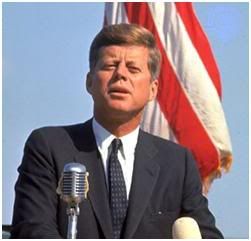 Figure 27: US President John Fitzgerald Kennedy (JFK).
Figure 27: US President John Fitzgerald Kennedy (JFK).
John Fitzgerald Kennedy (JFK) stood for the office of President of the United States on 02 January, 1960. At that time he was most widely known as the war hero turned congressman who had authored the Pulitzer Prize-winning book Profiles in Courage, rather than the author of the Harvard senior thesis turned best seller[1] Why England Slept.[2] In fact, Profiles in Courage was ghostwritten,[3] and despite its Pulitzer Prize, it is a mediocre book bordering on bad. If you want a glimpse into the kind of the mind that JFK possesed, then Why England Slept is the essential read. It is also a haunting read, because Kennedy’s thesis was that the British Empire was already in terminal decline by the early 1930s, and that Britain was in neither the military or economic condition to have opposed Hitler in Munich in 1938. Kennedy’s argument was simple, and in hindsight unassailable: Confront the Nazis in 1938 and rapidly loose the war. Appease them and buy time until the USSR and the US were brought into the conflict, or induced to materially assist Britain, and the war might well be won. When Kennedy finished his thesis in 1940, the verdict on victory was still out, and it would not be confirmed by history until five bloody years later.
Anyone who takes or accepts the credit for the intellectual workproduct of another man, as JFK did when he was complicit in the creation of Profiles in Courage, has shown himself to be a blackguard. It is therefore tempting to look at Why England Slept as merely an apologist tract for the pro-fascist politics of his father, Joseph P. Kennedy, and of pro-fascist-isolationist demographic in America and England in which he had been reared.[4] In the run up to the war, the US had been deeply divided in its sympathies. While there was a long tradition of Anglophilia stemming from the country’s roots as a British colony, there was also a large German and Irish population which regarded Great Britain with contempt, suspicion, or both.
The economic collapse resulting from the stock market crash in 1929 had led to profound social unrest and the emergence of vigorous socialist and communist political activism throughout the Western world. In Germany, Spain and Italy the advance of communism was seen to have been effectively stopped by Hitler, Franco and Mussolini, and perhaps even more importantly, to have been countered by a movement (Fascism) which offered economic recovery as well as eugenic improvement and a new “scientific system of government.” Mussolini made the Italian trains run on time and Hitler created a vast industrial infrastructure in Germany and pulled the country out of a catastrophic inflationary depression. Both men coupled these acommplishments with a showy ideology that sparkled with glamor and promised to bring order out of chaos. To many, Fascism offered the prospect of lasting peace and prosperity.
While JFK was reared in this ideological milieu, Why England Slept reveals an original thinker who was not just curious about geopolitical history, but able to draw significant and valid conclusions from surprisingly meager data. This ability may well have been the very thing that redeemed him from what, during his campaign for the Presidency, must have seemed a minor indiscretion, and but one of many, with the facts. At the time of JFK’s presidential campaign, elements inside the US Air force were engaged in a major disinformation campaign, principally to convince as many in government as possible, as well asthe American electorate, that there existed a “missile gap” between the USSR and the US. Following the launch of Sputnik in 1957, Air Force general Curtis LeMay and the corps of Air Force intelligence analysts, became convinced that the USSR had perhaps upwards of a hundred ICBMs.[5] By contrast, the US Central Intelligence Agency CIA (CIA) analysts argued that there were perhaps a dozen. As it turned out, there were only four; all of them liquid fuel SS-6 missiles which required hours of preparation to launch. By contrast, at that time the US had 170 land based Titan and Atlas ICBMs, and was quickly building more. It also had eight George Washington and Ethan Allen class ballistic missile submarines with the ability to launch 16 Polaris missiles; each with a range of 2,200 kilometres (1,400 mi).
“Small” Lie: Big Consequences
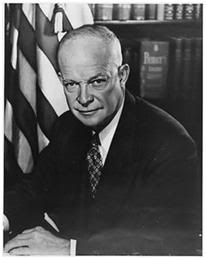 Figure 28: US President Dwight David Eisenhower.
Figure 28: US President Dwight David Eisenhower.
Once this debate between the Air Force and CIA analysts was leaked to the press, the Democrats argued that Republican President Dwight D. Eisenhower was not spending enough money on national security and that the US was, as a consequence, open to nuclear annihilation. In his 1960 campaign JFK echoed these charges and used them to considerable effect against his opponent. Later, he alleged he that he took this position because he did not have access to the intelligence data indicating that there was no missile gap, and that in fact the US had vast nuclear superiority in every sphere of nuclear weapons delivery (bomber, ICBM, IRBM, submarine). In fact, JFK had been extensively briefed by the Director of the CIA, Allen Dulles, in July of 1960 – as had his running mate, Senator Lyndon Johnson. Dulles summarized his briefing of the Democratic candidates in a letter to President Eisenhower in August of 1960. Eisenhower, who determined the scope of the briefing, was deeply disturbed by the emergence of what he termed the “military-industrial complex” and was suspicious that the “missile gap” was yet another manifestation of its endless thirst for taxpayer dollars for needless and costly high technology military infrastructure.
JFK and his campaign manager brother, Robert Kennedy, were savvy enough politicians to turn a deaf ear to the truth about the missile gap. Thus, when JFK won the presidency in 1960 he entered office in the position of being unable (and perhaps unwilling) to curtail the explosion in the number US nuclear offensive weapons. Indeed, it was not until USSR premier Nikita Khrushchev began applying pressure in the form of the Berlin Wall to “test” JFK’s mettle as a statesman and leader, that JFK conceded, first to Khrushchev, and later to the world, that not only was there no missile gap, but that the US held an enormous strategic lead. While not news to the Soviets, this public revelation put them in the difficult position of being made acutely and unavoidably aware that they were vulnerable to a “successful” first strike nuclear attack by the US.[6]
The Caribbean Crisis
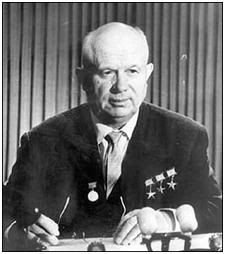 Figure 29: Soviet Premier Nikita Khrushchev.
Figure 29: Soviet Premier Nikita Khrushchev.
Khrushchev and the Politburo had good reason to be concerned about the new American President’s intention’s and aggressiveness following a US sponsored failed attempted invasion of the USSR’s ally, Cuba, in April 1961 (“The Bay of Pigs” invasion). Kennedy’s perceived “soft” response to the pressure applied from 4 June – 9 November 1961, the second “Berlin Crisis,” which resulted in the erection of the Berlin Wall, encouraged Khrushchev to pursue a redress to the imbalance of nuclear deterrence which both sides now knew and acknowledged existed. The USSR lacked the economic base to maintain ground based ICBM parity with the US, but what it could afford to do was to produce additional inexpensive intermediate range ballistic missiles (IRBMs) and, following the US’ lead in Turkey (with its Jupiter IRBMs), deploy them closer to the US – effectively negating the lack of intercontinental delivery capability. Cleverly, with this action, Khrushchev perceived that he could kill two birds with one stone: redress the missile gap – the real missile gap – and once and for all protect the USSR’s ally Cuba, from invasion by the US.
The Cuban Missile Crisis, the result of the decision taken to place intermediate and short range tactical nuclear ballistic missiles in Cuba, is not known by that name in the Russian speaking world. Rather, it is called the “Caribbean Crisis,” or alternatively, the “October Crisis.” Recently, I sat in Kiev, surrounded by a group of 20 and 30-something Russian and Ukrainian men (and one woman). I was to depart the following morning for the former Soviet ICBM complex in Pervomaysk, and a question had arisen as to why I was interested in going to such a grim place. At which point one of the group leaned forward and said, a bit expectantly, perhaps with irony and perhaps with a little bit of awe, “You know, Mike is the only person here who alive during the Caribbean Crisis!” This was answered by a chorus of “Ahhhs or Umms.” My response was grimmer still: “I was not only alive at the time; I’m old enough to remember it well.”
It is not unreasonable to view the Crisis through the lens of the conflicting ideologies and economic systems of the two nation-sate empires of the time. But to confine the discussion to that plane would be to miss the most important lesson it has to teach, in the same way that the Behaviorists of the first half of the 20th century failed to grasp the criticality of the inner workings of the mind, in giving rise to animal and human behavior. At its most fundamental level the Crisis was about a failure of two adversaries, and ultimately two men, to understand the intent and the fundamental values (moral, ethical and pragmatic) each held. The politics and the world views of the parties involved were important, but not nearly as important as what each side felt, viscerally, about the other.
The Western view of Russia and of communism, is that their economic system (collectivism) was a grotesque and nearly complete failure, which was the direct result of collectivist ideology and practice. This point of view was easily confirmed by examining the USSR, either by econometric criteria, or directly, by visiting. Russia’s GDP was approximately 10% of the US’s in the early 1960s, and the level of consumer well being and real wealth was a fraction of that in the US at the time. The US science fiction writer Robert Heinlein toured the USSR in 1960, and his travelogue of that visit was published in his book Expanded Universe in 1980. Heinlein argued that any notion that the USSR represented a threat to the US, or to the West, was ludicrous based on his own and his wife’s (Virginia Heinlein’s) firsthand observations of the Soviet standard of living, degree of technological achievement, and population demographics.
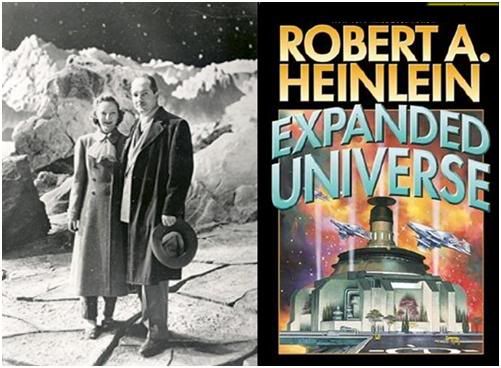 Figure 30: In 1960 science fiction author Robert Heinlein, and his third wife, Virginia Gerstenfeld Heinlein (both shown at left on the set of the movie Destination Moon to which Heinlein served as a technical adviser and script writer) toured the Russia where they were, by chance, present during the U-2 crisis when the Soviets shot down a US U-2 spy plane overflying the USSR to gather intelligence (primarily) on Soviet ICBM installations and captured its pilot, Francis Gary Powers (who had failed to use the cyanide ampoule provided to avoid just such a contingency). Virginia Heinlein became fluent in Russian prior to their visit to Russia for the express purpose of being better able to evaluate Soviet society. Both of the Heinlein’s were virulently anti-communist and anti-Soviet. The account of their visit to the USSR was not commercially published until 1980, when it appeared in a collection of Robert Heinlein’s works entitled Expanded Universe.
Figure 30: In 1960 science fiction author Robert Heinlein, and his third wife, Virginia Gerstenfeld Heinlein (both shown at left on the set of the movie Destination Moon to which Heinlein served as a technical adviser and script writer) toured the Russia where they were, by chance, present during the U-2 crisis when the Soviets shot down a US U-2 spy plane overflying the USSR to gather intelligence (primarily) on Soviet ICBM installations and captured its pilot, Francis Gary Powers (who had failed to use the cyanide ampoule provided to avoid just such a contingency). Virginia Heinlein became fluent in Russian prior to their visit to Russia for the express purpose of being better able to evaluate Soviet society. Both of the Heinlein’s were virulently anti-communist and anti-Soviet. The account of their visit to the USSR was not commercially published until 1980, when it appeared in a collection of Robert Heinlein’s works entitled Expanded Universe.
Heinlein wrote of the medieval state of the country outside of the major cities and he noted, correctly, that Russia was imploding in terms of population, as early as 1960. This latter conclusion was arrived at by the simple expedient of Virginia Heinlein asking every woman she met how old she was, her marital status, how many children she had, and so on; a simple and yet highly reliable way of gathering otherwise impossible to obtain demographic data. This was the kind of spying the CIA should have been doing at the time, and apparently was not. Heinlein went on to question the very possibility that the USSR could have any significant nuclear missile infrastructure in 1960-1. He did this all based on his observations of the general state of the Soviet economy, and of the particulars of that part of their high technology infrastructure he was able to examine as a VIP tourist in 1960. The CIA could have benefitted greatly from his analysis, if not from his rabidly anti-Soviet perspective.
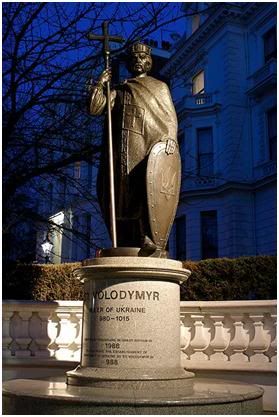 Figure 31: Vladimir in 988, CE. (Holland Park W11, London, UK)
Figure 31: Vladimir in 988, CE. (Holland Park W11, London, UK)
There is no question that this was indeed the state of the Soviet Union in 1960, and so at first glance, it would seem that the analysis of the Soviet Union, and Russia in particular, as a backward and economically blighted state with a contracting population[7],[8] was justified. However, that was not the whole picture and it fails to account for a number of very material anomalies for which the Russian speaking peoples may be properly credited with being unique. I know of no other example in history where a people have consistently and deliberately reached outside of their culture to select their core social technologies.
Perhaps the first and best documented example of this is the selection of Christianity as the new religion for the Russian people by Vladimir I in 987 CE. The history of Kievan Rus’[9] authored by the Kievan monk Nestor (1056 -1114 CE) during the reigns of Vsevolod I and Svyatopolk II, notes that in consultation with his boyars, Vladimir sent envoys to study the religions of neighboring nations. Nestor reports that Vladimir’s envoys reported back that the Muslim Bulgarians had “no gladness among them; only sorrow and a great stench and that Islam was undesirable due to its taboo against the consumption of alcohol and pork to which Vladimir is said to have remarked that “Drinking is the joy of the Russes. We cannot exist without that pleasure.”
Nestor also describes Vladimir evaluating Judaism and eventually rejecting it, noting that the Jews’ “loss of Jerusalem demonstrated they were no longer in God’s favor.” In the end, Vladimir decided upon Christianity, probably in no small measure because his envoys reported from Constantinople that, “We no longer knew whether we were in heaven or on earth,” describing a majestic High Mass in Cathedral Hagia Sophia, “nor such beauty, and we know not how to tell of it,” and because of the horrid end promised to nonbelievers come the end of the world and the day of last judgment. It should also be noted that substantial power and formidable wealth of the Byzantine Empire at that time was likely also no small disincentive. Forthwith, all of Rus was converted to Christianity by royal ukase.[10]
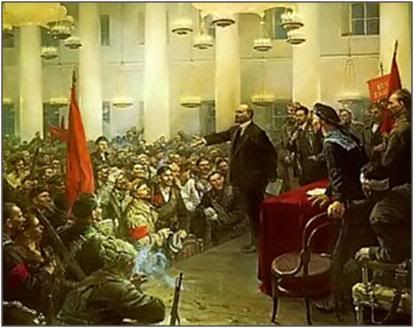 Figure 32: Vladimir Ilyich Lenin introduces a fundamentally new social and economic system, communism, to the Russian people in 1919.
Figure 32: Vladimir Ilyich Lenin introduces a fundamentally new social and economic system, communism, to the Russian people in 1919.
The adaptation of the Ancient Greek uncial alphabet by Cyril and Methodius, to create Russian Slavonic Cyrillic was a similarly “deliberate” decision, taken in order to facilitate the propagation of Christianity in the Rus via the written word.[11] This pattern of an active and often methodical search and adaptation or adoption of intellectual assets external to the Russian culture has been repeated throughout Russian history. Perhaps the most notable and most recent example of this was the adoption of a radical, untried and very alien economic system in the form of Marxist (-Lennist) communism.[12] The economist and economic historian Jack Hirshleifer has called the opening 5 years of Soviet Communism “the most extreme effort in modern times to do away with the system of private property and voluntary exchange.” It came at an enormous cost in lives and property, which under Stalin, grew to a grotesque and fantastic degree.
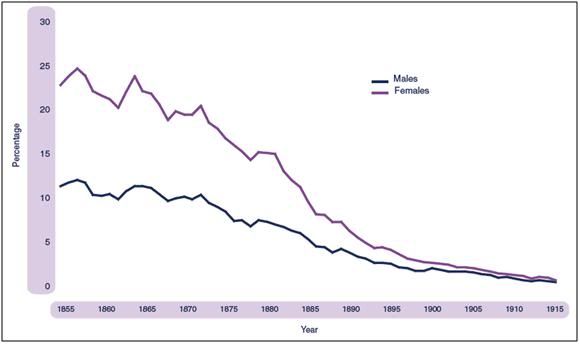 Figure 33: Illiteracy in Russia, by sex, between 1856 and 1915.
Figure 33: Illiteracy in Russia, by sex, between 1856 and 1915.
The idea that the inferiority of the USSR’s economic performance was solely an artifact of communism infuriated the Soviets, who believed that this judgment was fundamentally unfair and deliberately biased. To some extent, they were justified in this belief. At the time of the Russian Revolution in 1918, Russia was an agrarian monarchy that can only be described as being trapped somewhere between the Middle Ages and the 18th (not the 19th) century. Literacy rates prior to 1900 were in the range of 20%, and while they had risen to ~30% by 1920 (www.marxists.org/archive/lenin/works/1923/jan/02.htm) this should be contrasted with the literacy rate in the US which had been at ~ 90% since the US Revolutionary War in 1776; and a literacy rate in the United Kingdom at the start of the 20th century that was ~ 80%, by comparison.
The US, in addition to having a relatively stable governmental regime from 1800 to 1920, had also benefitted enormously from the abundance of “low hanging resource fruit” available to fuel its economic expansion.[13] At the cost of minimal blood and treasure the US had expanded westward, acquiring enormous assets in the spheres of agriculture, minerals, oil, and lebensraum. An even greater and often overlooked benefit was the vast influx of immigrants, both skilled and unskilled, and all able bodied [14] fleeing various failed and failing economies in Europe, as well as adverse religious, political, and social conditions in their home countries. This vast influx of youthful, often skilled and always able bodied human capital provided vast additional motive force to the engine of US economic expansion. The absence of any significant regulatory burden, near absence of institutionalized corruption, and ready access to vast natural resources drove the US economy forward in an unprecedented way.8
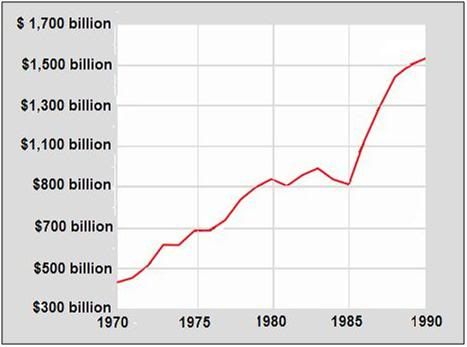 Figure 34: Growth in the USSR’s gross domestic product (GDP) from 1970 to 1990. Ofer, Gur. (1987). “Soviet Economic Growth, 1928 – 1985.” Journal of Economic Literature 25(4):1767 – 1833, and Easterly, William, and Fischer, Stanley. (1995). “The Soviet Economic Decline: Historical and Republican Data.” World Bank Economic Review 9 (3):341 – 371.
Figure 34: Growth in the USSR’s gross domestic product (GDP) from 1970 to 1990. Ofer, Gur. (1987). “Soviet Economic Growth, 1928 – 1985.” Journal of Economic Literature 25(4):1767 – 1833, and Easterly, William, and Fischer, Stanley. (1995). “The Soviet Economic Decline: Historical and Republican Data.” World Bank Economic Review 9 (3):341 – 371.
 Figure 35: Growth in the US gross domestic product (GDP) from 1970 to 1990 (blue) compared with the averaged (curve smoothed) growth of the Soviet GDP over the same period of time.
Figure 35: Growth in the US gross domestic product (GDP) from 1970 to 1990 (blue) compared with the averaged (curve smoothed) growth of the Soviet GDP over the same period of time.
Russia, while gifted with enormous natural resources, lacked the well developed and industrially capable base of human capital that the US enjoyed during the same period, and it was also plagued by a large burden of corruption in the pre-Soviet era. [15] These facts alone would have served as a basis for Soviet antipathy towards the West’s evaluation of Soviet economic performance during the interval from 1918 to 1961. However, an additional and wholly justified source of Soviet resentment of the Western criticism of “deficient” Soviet economic growth and prosperity, was the effect of WWII on the Soviet economy and the Russian speaking peoples. It is hard for most Westerners who lived through WWII, let alone those alive now, to even begin to understand the devastating impact that the Great Patriotic War (the name by which the Russian speaking peoples refer to WWII, and in particular their prosecution of the war on its eastern front), had on the Soviet economy and on the Soviet peoples.
The Eastern theatre of World War II was the most lethal and costly conflict in human history to date. In excess of 30 million people were killed in this conflict[16] with brutality exercised on the civilian and combatant populations by both sides (i.e., Nazi and Soviet) that was without parallel in scale, if not cruelty, in the history of warfare. As Time magazine noted in a 2008 retrospective on the war in the Eastern theatre: “By measure of manpower, duration, territorial reach and casualties, the Eastern Front was as much as four times the scale of the conflict on the Western Front that opened with the Normandy invasion.”[17]
 Figure 36: The blue line shows the probable rate of population growth and the likely absolute numbers that would have been expected if Russia had not experienced the great Patriotic War. Population growth was set back ~ 20 years as a consequence of the war. The relative sharp increases and decreases in population that occurred from 1900 to 1939 were an artifact of the Russian Empire losing territories with ~ 30 million people after the Russian Revolution (Poland 18 mil; Finland 3 mil; Romania 3 mil; the Baltic States 5 million and Kars to Turkey 400 thousands). World War II Losses were estimated between 25-30 million, including an increase in infant mortality of 1.3 million. Total war losses include territories annexed by USSR in 1939-45.
Figure 36: The blue line shows the probable rate of population growth and the likely absolute numbers that would have been expected if Russia had not experienced the great Patriotic War. Population growth was set back ~ 20 years as a consequence of the war. The relative sharp increases and decreases in population that occurred from 1900 to 1939 were an artifact of the Russian Empire losing territories with ~ 30 million people after the Russian Revolution (Poland 18 mil; Finland 3 mil; Romania 3 mil; the Baltic States 5 million and Kars to Turkey 400 thousands). World War II Losses were estimated between 25-30 million, including an increase in infant mortality of 1.3 million. Total war losses include territories annexed by USSR in 1939-45.
Both Nazi Germany and the Soviet Union utilized “scorched earth” tactics, with the Soviet Union suffering 20 million civilian deaths and total human losses of 26.6 million.[18] The Soviets destroyed as much as possible of their infrastructure and materiel (military and civilian) that they could not evacuate in order to deprive the advancing forces of any benefit. Subsequently, as the Germans retreated from formerly occupied territories, particularly in Ukraine, Russia’s breadbasket, SS Commander Heinrich Himmler ordered SS-Obergruppenfuehrer Prutzmann: “to leave behind in Ukraine not a single person, no cattle, not a ton of grain, not a railroad track … The enemy must find a country totally burned and destroyed.” (September 7, 1943).[19] Acting in concert, the SS and the Wermacht destroyed 18,414 miles of rail lines, flooded mines, razed factories and poisoned countless wells.
In excess of 2 million homes and other structures were burned razed. Nazi Ostland Administrator Erich Koch ordered that “the homes of recalcitrant natives … are to be burned down; relatives are to be arrested as hostages.” The Soviets estimated that the retreating Germans “razed and burned over 28,000 villages and 714 cities and towns, leaving 10,000,000 people without shelter. More than 16,000 industrial enterprises, more than 200,000 industrial production sites, 27,910 collective and 872 state farms, 1,300 machine and tractor stations, and 32,930 general schools, vocational secondary schools and higher educational institutions of Ukraine were destroyed. Thus, the USSR was subjected to two rounds of comprehensive and devastating destruction of its resources and productive infrastructure.
The direct damage to the Ukrainian national economy caused by the fascist occupation came to 285,000,000,000 rubles.[20] Large numbers of Ukrainians were deported to the Reich for slave labor. The historian Geoffrey A. Hosking has noted that “The full demographic loss to the Soviet peoples was even greater than the raw numbers indicate, since a high proportion of those killed were young men of child-begetting age, the postwar Soviet population was 45 to 50 million smaller than post-1939 projections would have led one to expect.”[21] Considering the economic impact of WWII using total population loss from 1939 to 1945 as a surrogate marker: US losses were 0.32% of the population, UK losses were 0.94% and the USSR‘s losses were a staggering 13.88% of the population, with much of this demographic consisting of young and able bodied individuals at or near their peak period of productivity and reproductive potential.[22]
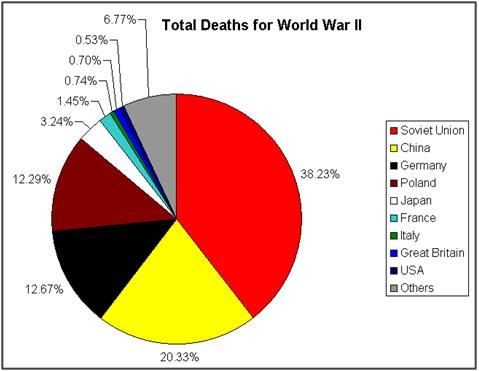 Figure 37: The mind-numbing human losses suffered by the USSR during the “Great Patriotic War” are put into perspective when compared with the total human losses of the other nation-states involved in the conflict.
Figure 37: The mind-numbing human losses suffered by the USSR during the “Great Patriotic War” are put into perspective when compared with the total human losses of the other nation-states involved in the conflict.
What is widely remembered and understood is that the USSR achieved a military victory over Nazi Germany. Too often not considered is that the property damage inflicted by the Axis invasion was estimated to be on the order of 679 billion rubles. The war resulted in the complete or partial destruction of 1,710 cities and towns, 70,000 villages, 2,508 church buildings, 31,850 industrial facilities, 40,000 miles of railroad, 4100 railroad stations, 40,000 hospitals, 84,000 schools, and 43,000 public libraries. And the majority of the USSR’s livestock were slaughtered for food, to prevent exploitation by the enemy or as a result of starvation, disease or escape from captivity.[23]
It is interesting to note that despite its communist/socialist economy, the victory of the USSR over the Axis was in large measure a result of its war industry being able to consistently outperform the Germans, despite the enormous loss of population and land. Stalin’s much ridiculed five-year economic plans, carried out during the 1930s, had resulted in the industrialization of the Urals and central Asia – albeit at great cost in human life and suffering. In 1941, the same trains that transported Soviet troops to the Eastern front were used to evacuate thousands of hastily disassembled factories from Belarus and Ukraine, to areas far removed from the front line. When this industrial capacity was reconstituted east of the Urals, war production could be continued safely out of reach of Luftwaffe bombers. The large increases in the production of war materiel that were necessary to sustain the Soviet war effort were achieved by a large reduction in the civilian standard of living via the application of “total war,” in conjunction with assistance from the US and the UK in the form of the Lend-Lease program, which shipped vast amounts of war materiel via the famed Murmansk convoys.[24]
As German manpower losses mounted and became critical during the last half of the war, they were able to compensate for manpower attrition through the use of slave labor from conquered Eastern European countries, interned Jews and Soviet POWs. Despite the German’s superior production of raw materials they were unable to approach; let alone match Soviet production of war materiel. Much of this disparity was due to a fundamental difference in Soviet manufacturing strategy. In 1943 the Germans made an explicit strategic decision to improve quality over quantity in the production of war materiel, whereas by contrast, the Soviets settled on a strategy to refine and simplify the designs of existing military hardware while steadily increasing the volume of production.
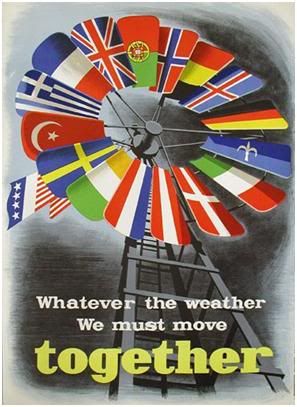 Figure 38: Poster promoting the Marshall Plan (ERP) circa 1950. Note that US flag comprises the wind vane which is the “tail” that helps keep the windmill pointed into the wind and thus on track to generate motive force.
Figure 38: Poster promoting the Marshall Plan (ERP) circa 1950. Note that US flag comprises the wind vane which is the “tail” that helps keep the windmill pointed into the wind and thus on track to generate motive force.
By contrast, the US experienced trivial losses in manpower, capital and systemic infrastructure (i.e., roads, power plants, factories, etc.) and in fact emerged from the war in a better position in terms of global infrastructure and industrialization that when it entered it. The end of WWII also saw the US become a first-class imperial power, replacing Great Britain as the world’s foremost superpower. The US exercised economic and political control over Japan and West Germany via the Marshall Plan (European Recovery Program, ERP) was the $13 billion US aid program to facilitate the rebuilding of European infrastructure and economies in the aftermath of WWII primarily to contain the spread of communism and provide a viable export market for US manufactured goods.[25] The ERP operated from 1948 to 1952 and succeeded in vastly increasing Western European productivity, standard of living and wealth, in no small measure as a result of what has been called the “bonfire of the regulations” wherein international trade barriers were largely eliminated (Europe) and choking internal regulation, excessive taxation and corruption/favoritism were largely swept away. By 1952 as ERP funding ended, the economy of every participating nation-state had surpassed pre-war levels; for all ERP recipients, output in 1951 was at least 35% higher than in 1938.[26], [27]
The ERP was also offered to the USSR and its client states, but they did not accept it. In late September of 1947, the Soviet Union called a meeting of the nine European Communist parties in southwest Poland.[28] The position of the USSR regarding the ERP was that “international politics is dominated by the ruling clique of the American imperialists” who are intent upon the “enslavement of the weakened capitalist countries of Europe.”The communist parties in Europe were instructed initiate a guerrilla struggle, including the use of “sabotage,” against US imperialism in Europe [29] The report further claimed that “reactionary imperialist elements throughout the world, particularly in the U.S.A., in Britain and France, had put particular hope on Germany and Japan, primarily on Hitlerite Germany — first as a force most capable of striking a blow at the Soviet Union.”[30]
The paranoid response to the ERP was likely a result of a complex interaction of factors including Stalin’s psychopathic and paranoid personality, the intense anger and resentment of the USSR to the punishing economic and human losses suffered on the Easter Front in the Great Patriotic War, and finally, deep and not wholly unjustified mistrust of the US’ intentions to profit from and expand its global sphere of influence, as indicated by language in the report to the effect that “the bosses of Wall Street” are “taking the place of Germany, Japan and Italy.” [31]The ERP was also described by the Kremlin as “the American plan for the enslavement of Europe” [32] and it described the global geopolitical situation as being divided “into basically two camps—the imperialist and antidemocratic camp on the one hand, and the anti-imperialist and democratic camp on the other”.[33]
Viewed in this light, the deliberate transformation of Russia into a world class industrial economy (second only to the US) by 1952 in the aftermath of the 1918 Revolution and in the face of the unprecedented devastation and disruption suffered by the Soviet state during WWII, looks considerably more impressive. It is also worth noting that during the early period of nuclear proliferation (1960 to 1970) the Russian economy grew at an impressive rate of ~5% per year – in the absence of capitalism!
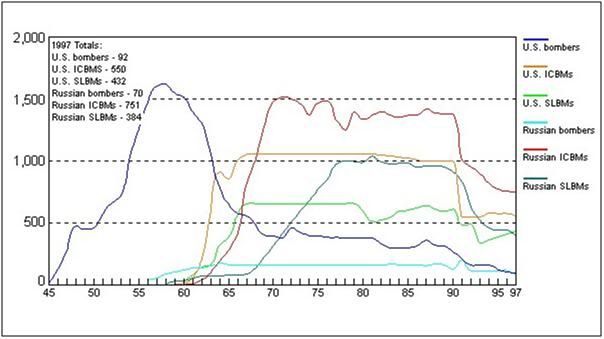 Figure 39: US and USSR/Russian Strategic Offensive Nuclear Forces, 1945-1997. Note that the US was solidly ahead in ICBM capability until circa 1968 and that the US maintained strategic superiority or parity with the USSR throughout the course of the Cold War. Source: Robert S. Norris and Thomas B. Cochran, U.S.-USSR/Russian Strategic Offensive Nuclear Forces, 1945-1996, Nuclear Weapons Databook Working Paper 97-1 (Washington, D.C.: Natural Resources Defense Council, January 1997); Robert S. Norris and William M. Arkin, “NRDC Nuclear Notebook (U.S. Strategic Nuclear Forces, End of 1997),” Bulletin of the Atomic Scientists, January/February 1998, pp. 70-72.; Robert S. Norris and William M. Arkin, “NRDC Nuclear Notebook (Russian Strategic Nuclear Forces, End of 1997),” Bulletin of the Atomic Scientists, March/April 1998, pp. 70-71.
Figure 39: US and USSR/Russian Strategic Offensive Nuclear Forces, 1945-1997. Note that the US was solidly ahead in ICBM capability until circa 1968 and that the US maintained strategic superiority or parity with the USSR throughout the course of the Cold War. Source: Robert S. Norris and Thomas B. Cochran, U.S.-USSR/Russian Strategic Offensive Nuclear Forces, 1945-1996, Nuclear Weapons Databook Working Paper 97-1 (Washington, D.C.: Natural Resources Defense Council, January 1997); Robert S. Norris and William M. Arkin, “NRDC Nuclear Notebook (U.S. Strategic Nuclear Forces, End of 1997),” Bulletin of the Atomic Scientists, January/February 1998, pp. 70-72.; Robert S. Norris and William M. Arkin, “NRDC Nuclear Notebook (Russian Strategic Nuclear Forces, End of 1997),” Bulletin of the Atomic Scientists, March/April 1998, pp. 70-71.
The cost of the Cold War was staggering; for the US the bill was $19.65 trillion (1948-1991) in 2010 dollars, of which $8,731.5 billion (also in 2010 dollars) was expended directly for nuclear arms.[34], [35] Precise data for the dollar cost of the Cold War to the USSR are not available, however it is generally believed that the Soviet Union spent 12-13% of its GDP on military programs in direct support of the Cold War. The cost in hardship to Soviet citizens was vastly greater than this fraction of the GDP might suggest due to the smaller size and lower level of technological sophistication of the Soviet economy. As the CIA noted in its 1977 A Dollar Cost Comparison of Soviet and US Defense Activities, 1966-1976 (Secret):
“…the dollar cost comparison shows Soviet defense activities to exceed those of the United States by about 40 percent in 1976. If both are measured in terms of estimated ruble costs, the Soviet activities are about 25 percent larger than the US. Thus, the effect of the index number problem is not large enough to alter the basic conclusion that Soviet defense activities overall are currently larger than those of the United States.”[36]
The election of JFK, in significant measure on the basis of a bald faced lie about a mythical missile and nuclear arms gap between the US and the USSR, was, in effect, a green light given by the American electorate for the indefinite enfranchisement of Eisenhower’s darkest nightmare for the post WWII world; the creation of the “military-industrial complex,” and with it the increased likelihood of global thermonuclear annihilation. JFK’s new military strategy, known as “Flexible Response,” constituted a commitment for the US and its allies to remain on a wartime footing and a wartime economy until the Cold War ended in 1991. Beyond the horrendous cost in dollars, the myth of the missile gap further corroded US-Soviet relations, created unnecessary doubt and anxiety in both US citizens and America’s allies. Those in the know in positions of leadership in other nations and in multinational corporations must have had frequent occasion to ask themselves, “If the US, with its massive economy and enormous technological base cannot maintain nuclear parity with the USSR, which is in reality an emerging Third World nation, what kind of leadership and security can we expect from the US?”
If Soviet expenditures for the Cold War were indeed on a par with those of the US, then the approximate dollar value for whole endeavor by both sides would be in the range of $40 trillion 2010 US dollars. To put that into perspective, that is also, give or take, the approximate net worth of the United States of America, at current market value, e.g., $50-60 trillion US! While not the only factor in the collapse of the USSR, the Cold War was very material in its financial implosion. The US and the rest of the West have been said to have “won” the Cold War, with the tacit assumption being that the US, unlike the USSR, did not spend itself into bankruptcy making weapons of mass destruction and creating and supporting the enormous infrastructure required for their care and feeding. For myself, I doubt very much that the West will escape without paying the same price the USSR did, and possibly considerably more, and with interest.
As peoples, we squandered the funds that would have paid for us to become a space-faring people, to develop self sustaining industrial technology, and above all, to have made vast strides in the life extension sciences – in particular, with respect to developing suspended animation – and thus, medical time travel. Failure to achieve the latter has condemned billions of human beings to death, making it by far the most expensive war in dollars and lives in the entire history of our species. We cannot continue in this fashion if we are to survive, either as individuals, or as a species. Having said that, there are many lessons we can learn from the Cold War and the effects of its aftermath, which we are now suffering. Some of those lessons will be discussed directly.
End of Part 3
References & Footnotes
[1] The book was made a best seller in large measure by Kennedy’s powerful and influential father, Jospeh P. Kennedy
[2] Kennedy, John F. Why England Slept , Funk, New York, 1940. Reprinted by Greenwood Press, ISBN 0313228744 (1981).
[3] Parmet, Herbert S. Jack: the struggles of John F. Kennedy. Dial Press, New York (1980).
[4]Swift, Will. The Kennedys Amidst the Gathering Storm: A Thousand Days in London, 1938-1940. Collins/Smithsonian, 352p. ISBN 978-0-06-117356-1 (2008).
[5] Goodman, Melvin A. “Exaggeration Of The Threat: Then And Now“, The Public Record, 14 September 2009. Retrieved 04-19-2011.
[6] Preble, Christopher, John F. Kennedy and the Missile Gap, Northern Illinois University Press , ISBN-10: 0875803326 (2004).
[7] “Demography and development in Russia“, UN Development Program, 28 April 2008. Retrieved 04-11-2011.
[8] Global decline in the Russian population did not occur until much later, however, the beginnings of this process were correctly noted by Virginia Heinlein whose questioning was necessarily confined to large cities in Russia where the Heinlein’s were permitted to visit. Population collapse typically starts in cities where the reproduction rate is lower than in rural and agricultural demographics.
[9] Chadwick, N. G. The Beginnings of Russian History: an Enquiry into Sources, Cambridge University Press, ISBN 0-404-14651-1 (1946).
[10] Moss, Walter G. “A History of Russia Volume I: To 1917,” Anthem Press, London (2002).
[11] The World’s Writing Systems. Oxford University Press. ISBN 0-19-507993-0 (1996).
[12] Richman, Sheldon, “War Communism to NEP: The Road to Serfdom” (PDF). The Journal of Libertarian Studies 5 (1): 89–97, (1981): http://mises.org/journals/jls/5_1/5_1_5.pdf. Retrieved 04-19-2011.
[13] Cowen, Tyler, The Great Stagnation: How America Ate All The Low-Hanging Fruit of Modern History, Got Sick, and Will (Eventually) Feel Better: A Penguin eSpecial from Dutton [Kindle Edition], ASIN: B004H0M8QS (2011).
[14] All immigrants to the US were screened for disease and able-bodied status before being allowed to enter the country; Ellis Island, NY was the principal intake and quarantine facility used for this purpose.
[15] The Great Patriotic War of the Soviet Union, 1941-45: A Documentary Reader, Routledge, pp. 5712-7 ISBN 978-0-7146- (2008).
[16] Krivosheev, G.I. Soviet Casualties and Combat Losses, Greenhill ISBN 1-85367-pp. 280-7 (1997).
[17] Bonfante, Jordan (23 May 2008). “Remembering a Red Flag Day” Time: http://www.time.com/time/world/article/0,8599,1809018,00.html.
[18] Hosking, Geoffrey A. “Rulers and victims: the Russians in the Soviet Union,” Harvard University Press, Harvard, MA. p. 242. ISBN 0-674-02178-9 (2006).
[19] Dallin, Alexander. German Rule in Russia 1941-1945, Macmillan, London (1957).
[20] Bazhan, M.P. ed. Soviet Ukraine ( Kiev: Editorial Office of the Ukrainian Soviet Encyclopedia, 1969), 569p. Published by the Academy of Sciences of the Ukrainian SSR.
[21] Hosking, Geoffrey A. Rulers and victims: the Russians in the Soviet Union. Harvard University Press, Harvard MA, p.242. ISBN 0-674-02178-9 (2006).
[22] http://en.wikipedia.org/wiki/World_War_II_casualties
[19] Hosking, Geoffrey A. Rulers and victims: the Russians in the Soviet Union. Harvard University Press, Harvard MA, p.242. ISBN 0-674-02178-9 (2006).
[20] http://en.wikipedia.org/wiki/World_War_II_casualties. Retrieved 05-25-2011.
[21] The New York Times, 9 February 1946, Volume 95, Number 32158.
[22] The Lend-Lease program operated in the form a loan. Repayment of that loan to the US proved a significant drain on the economies of its Allies. The UK completed its debt repayment to the US in 2004 and the USSR in 2006: http://www.telegraph.co.uk/finance/2945924/Reborn-Russia-clears-Soviet-debt.html. Retrieved 05-11-2011.
[23] Milward, Alan S. The Reconstruction of Western Europe 1945-51, Berkeley, University of California Press (2006).
[24] Eichengreen, Barry, The European Economy since 1945: Coordinated Capitalism and Beyond, p. 57 (2008).
[25] Mills, Nicolaus, Winning the peace: the Marshall Plan and America’s coming of age as a superpower. Wiley. New York, ISBN 978-0-470-09755-7, p. 195 (2008).
[26] Behrman, Greg. Most noble adventure the Marshall plan and the time when America helped save Europe. New York, Free Press, (2007).
[27] Wettig, Gerhard, Stalin and the Cold War in Europe, Rowman & Littlefield, New York, ISBN 0742555429, p. 146 (2008).
[28] Wettig, Gerhard, Stalin and the Cold War in Europe, Rowman & Littlefield, New York ISBN 0742555429, p.142 (2008).
[29] Behrman, Greg. Most noble adventure the Marshall plan and the time when America helped save Europe. New York, Free Press, 2007.
[30] Wettig, Gerhard, Stalin and the Cold War in Europe, Rowman & Littlefield, ISBN 0742555429, p. 146 (2008).
[31] Wettig, Gerhard, Stalin and the Cold War in Europe, Rowman & Littlefield, ISBN 0742555429, p. 145 (2008).
[32] Rhodes, Richard, Arsenals of Folly: The Making of the Nuclear Arms Race, Knopf, New York (2007).
[33] Stephen I. Schwartz, ed., Atomic Audit: The Costs and Consequences of U.S. Nuclear Weapons Since 1940, (Washington, DC: Brookings Institution Press, 1998). Further information about Atomic Audit can be found at <http://www.brookings.edu/projects/ archive/nucweapons/weapons.aspx>. Retrieved 06-11-2011.
[34] CIA, A Dollar Cost Comparison of Soviet and US Defense Activities, 1966-76 (Secret) SR-77-10140, October 1977, p. 2.

You know, I have never understood why so many people think JFK was such a great president.
Because he was a DRAMATIC president. He was young, intelligent, charismatic, had a beautiful wife and cute kids. He also created devilishly bad situations and then pulled the irons out of the fire at the last minute – at least with the Cuban Missile Crisis (CMC). Not so much with Bay of Pigs. Kennedy would have been a remarkable, if not a great President, if he has inherited the CMC and then went on to handle it as he did. He was capable of learning from history, and in fact the book that changed his thinking about the CMC was Barbara Tuchman’s brilliant analysis of the root causes of WWI, THE GUNS OF AUGUST. Similarly, had he applied the clear headed analysis of Soviet economics and internal conditions that he demonstrated he was capable of in WHY ENGLAND SLEPT, he might have made major changes in US foreign policy, and the arms race. Had he lived to finish his Presidency, there is almost no doubt in my mind that he would have reversed the escalation in Vietnam and gotten the US out in exactly the way French got out.
He was terribly young and inexperienced, and how on earth one trains for a job like the Presidency of the US is beyond me. It’s a difficult job, not just because of the decisions you get to make in a proactive way, but (more so) because you must avoid mistakes and misunderstandings that will lead to explosive escalation. It’s a lot like defusing bombs and handling high explosives for a living. Eisenhower had remarkably good reasoning skills and enormous wisdom. If you contrast the two men, you can see at once the advantage that age, and the experience of commanding in WWII, bestowed on Eisenhower (and that was lacking in Kennedy). I cannot begin to imagine Eisenhower countenancing escapades like the Bay of Pigs, or trying to kill Castro, let alone with poisoned pens or LSD.
Finally, I think Kennedy saw the Presidency as a “big deal,” as an opportunity to make his mark on history – not to any special end – not to end slavery, or even go to the moon. The best the CEO of an extant empire can do is to minimize the evil it does while maximizing its stability and prosperity. It’s a custodial job that requires yeoman-like work. Unless, of course, you are bent on either expanding the empire, or holding onto it when it is no longer economically viable to do so. A good example of the latter is Churchill, who was a horrible CEO of the British Empire in decline, but who was absolutely essential to the survival of Britain in WWII. — Mike Darwin
Just a note that the United States is currently spending over $1 trillion dollars a year on its military, more than the rest of the world combined.
http://laudyms.wordpress.com/2010/04/19/defense-spending-is-much-greater-than-you-think-more-than-1trillion-a-year/
MD wrote:
==========================
The Entropy of Empire
There are, no doubt, many reasons why men aspire to become the chief executive officers (CEOs) of nation-states turned empires, not the least of which is a sincere desire to directly effect the course of these empires’ decision making and thus, history. Rarely is this opportunity granted, because nation-states, and especially imperial nation-states, are driven by an overweening self interest that is nearly perfectly inscrutable. Thus, the course of empires is goverened not so much by the conscious decisions of individual men, as it is by the inevitable collapse of empires; what I call the the “entropy of empire.”
======================
I have a different analysis: so called empires like the USA, the soviet union, china, the british empire, the roman empire etc are created by forces exerted by the rich, exerted downwards, and they are destroyed by forces exerted by the workers, exerted upwards.
The creation of the USA is documented in the writings of its creator, James Madison. He wrote that he created the federal union in order to disempower the people and thereby thwart democracy by disuniting the majority, and thereby protecting the rich from the majority. His words.
When we workers take down this american federalist empire, it will be by starving the beast and sending taxation and spending power back to the states, thus creating a higher degree of democracy by more closely uniting the majority in each state, and thereby enhancing democracy. Democracy is what the majority seeks.
Reagan did not kill off the Soviet Union. Detroit and japan. In the 80s, cars were quite fuel efficient. (even more than today, because they were lighter. (Laws created from the top have made cars heavier and thus less fuel efficient than they could be.) The effect of all these fuel efficient cars was to drive down the price of oil. Russia is rich in oil. That oil money was used to keep the satellite soviet states happy. Once the price of oil fell, the money dried up, and the satellite states went their own ways. Why? Because they wanted more democracy. With no oil money coming in, the puppets of russia that ruled in the satellite states were swept out of power, and new parliamentarian (and thus highly democratic) forms of government were installed in the satellite states. Of course in russia itself, federalism still reigned because it is too large for the people to actually wrest control of it from the rich.
you wrote:
==========================
The entropy of empire narrows and constrains the choices any individual actor can make, and does so most powerfully with respect to actions of the CEO. As a result, the most powerful influence an imperial CEO or emperor is likely to have will occur not as a consequence of the formal or deliberate decisions he makes, but rather, as a consequence of his unintended actions.
==================
You have a top down orientation. You look at events from the perspective of the rich and powerful. I look at them from the perspective of the workers.
you wrote:
==================
If you doubt the former, it is only necessary to look to the economic and international policies of the ostensibly liberal Democratic US President, Barac Obama, taken since he assumed the Presidency in 2004, and contrast them with those of George W. Bush, his “ultra-conservative” Republican predecessor. Because the entropy of empire is in play, it is hard to tell where the forigen or economic policy of Bush left off, and that of Obama began.
=====================
I agree that obama is not that different from bush, but what about one of his beliefs–that lasting change comes only slowly. It’s true.
you wrote:
=================
There is an unfortunate tendency to think of empires solely in geopolitical terms; as agglomerations of nation-states and territories spanning continents and being possessed of vast wealth and power. In fact, empires come in all sizes, and while all are, relatively speaking, both wealthy and powerful (and ultimately profligate and failed) they can exist whenever conditions allow for the dominance and control of an asset deemed essential by some fraction of the population. The Roman catholic Church prior to the Reformation and the company owned Appalachian mining town are both examples of empires that can exist apart from the nation-state (and even within it), writ both very large and very small. It is a peculiarity of cryonics under current conditions that, because of its lack of widespread societal aceptance, the absence of meaningful qualitative feedback, and the high threshold of resources and credibility required to capture any of the current microscopic market [BUT WHY IS IT SO MICROSCOPIC?], new ventures are effectively prohibited, at least within the US. Thus are empires made, and once made, they go on until their time is up; until their entropy collapses them.
=====================
you wrote:
===============
Anyone who takes or accepts the credit for the intellectual workproduct of another man, as JFK did when he was complicit in the creation of Profiles in Courage, has shown himself to be a blackguard.
====================
One thing that scares me about you is your moral absolutism and certainty that you are right.
you wrote:
===============
The economic collapse resulting from the stock market crash in 1929 had led to profound social unrest and the emergence of vigorous socialist and communist political activism throughout the Western world.
================
Actually it began much earlier. Really it started in the 1600s. There was a wave of populism that not only resulted in the french revolution, but also resulted in the creation of the USA and the destruction of the articles of confederation. Shays’ Rebellion, the Whiskey Rebellion, even that surrounding of the building where Madison and the other elites were hammering out the details of the new federalist pseudo-democracy (disgruntled and unpaid war vets surrounded the building, stuck their rifle barrels into the windows. Madison had to shoulder his way out of the crowd (they should have hung the little monster) (btw that incident caused madison to place the new capital in DC because it was isolated from the working class majority who he was afraid would burn down the capitol)).
Further examples of the wave of populism that began well before the Depression was the Haymarket affair. You can get a good idea of how strong that wave of populism was by looking at the Red Scare political cartoons of the 1910s and early 1920s. They used to be on baruch.edu.
you wrote:
===============
In Germany, Spain and Italy the advance of communism was seen to have been effectively stopped by Hitler, Franco and Mussolini, and perhaps even more importantly, to have been countered by a movement (Fascism) which offered economic recovery as well as eugenic improvement and a new “scientific system of government.” Mussolini made the Italian trains run on time and Hitler created a vast industrial infrastructure in Germany and pulled the country out of a catastrophic inflationary depression.
=====================
I suspect that the elite exaggerate the effects of hyperinflation because it wipes out the debts that the workers owe to them.
you wrote:
===============
Both men coupled these acommplishments with a showy ideology that sparkled with glamor and promised to bring order out of chaos.
================
One way that Hitler kept power was by giving the wealth of the jews to the people. The pogroms were in some ways a wealth redistribution program.
you wrote:
===============
At the time of JFK’s presidential campaign, elements inside the US Air force were engaged in a major disinformation campaign, principally to convince as many in government as possible, as well asthe American electorate, that there existed a “missile gap” between the USSR and the US.
=================
Ah, yes. The missile gap. Read Chomsky’s book on the spectacular achievements of propaganda.
The elite are so adept at finding ways to fund wars. The Lusitania, The Maine, The Tonkin Gulf, Pearl Harbor, Kuwaiti Rape Rooms, Weapons of Mass Destruction.
Instead of Homo Sapiens Sapiens, shouldn’t we more properly be labeled Homo Sapiens Propagandus?
you wrote:
===============
The Western view of Russia and of communism, is that their economic system (collectivism) was a grotesque and nearly complete failure, which was the direct result of collectivist ideology and practice.
=======================
It was really collectivist; more like pseudo collectivist. Collectivism can only take place on the local level.
The Soviet system, along with Red China’s system, was really a grab of power and wealth by posturing politicians. The wealth was owned by the elite there just like it is here.
You can put a feather in your hand and call it macaroni, but it still just a feather.
you wrote:
===============
As peoples, we squandered the funds that would have paid for us to become a space-faring people,
==============
Thank Dog the space race is over. What a bunch of nonsense. I too once a heinlein-phile, wanting to go into space.